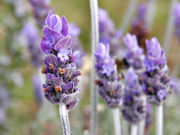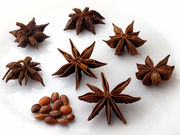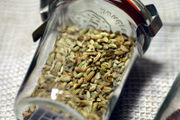List of essential oils
2007 Schools Wikipedia Selection. Related subjects: Food and agriculture
| Plant oils | |
|---|---|
| Types | |
| Vegetable fats | (list) |
| Essential oil | (list) |
| Macerated | ( list) |
| Uses | |
| Drying oil - Oil paint | |
| Cooking oil | |
| Fuel - Biodiesel | |
| Aromatherapy | |
| Components | |
| Saturated fat | |
| Monounsaturated fat | |
| Polyunsaturated fat | |
| Trans fat | |
Essential oils are extracted by distillation. The principal uses of essential oils are as flavoring agents, and medical and aromatherapy applications. Essential oils should also not be confused with macerated oils, where plant materials are infused in a base oil. Tarragon oil, for example, is oil distilled from the tarragon plant. Tarragon leaves in olive oil are sometimes used in cooking, and can also be called tarragon oil.
- Agar oil, distilled from Agarwood ( Aquilaria malaccensis). Highly prized for its fragrance.
- Ajwain oil, distilled from the leaves of Bishop’s weed ( Carum Copticum). Oil contains 35-60% thymol.
- Angelica root oil, distilled from the Angelica archangelica.
- Anise oil, from the Pimpinella anisum, rich odour of licorice, used medicinally.
- Balsam oil, from the Myroxylon pereirae.
- Basil oil is used in making perfumes, as well as in aromatherapy
- Bergamot oil, used in aromatherapy and in perfumes.
- Buchu oil, made from the buchu shrub. Considered toxic and no longer widely used. Formerly used medicinally.
- Cannabis flower essential oil, used as a flavoring in foods, primarily candy and beverages. Also used as a scent in perfumes, cosmetics, soaps, and candles.
- Caraway oil, used a flavoring in foods. Also used in mouthwashes, toothpastes, etc. as a flavoring agent.
- Cardamom seed oil, used in aromatherapy and other medicinal applications. Extracted from seeds of subspecies of Zingiberaceae (ginger). Also used as a fragrance in soaps, perfumes, etc.
- Carrot seed oil (essential oil), used in aromatherapy.
- Cedarwood oil, primarily used in perfumes and fragrances.
- Chamomile oil, used medicinally and in aromatherapy.
- Cinnamon oil, used for flavoring.
- Citronella oil, from a plant related to lemon grass is used as an insect repellent, as well as medicinally.
- Clove leaf oil, used as a topical anesthetic to relieve dental pain.
- Costmary oil (bible leaf oil), from the Tanacetum balsamita
- Cranberry seed oil, equally high in omega-3 omega-6 fatty acids, primarily used in the cosmetic industry.
- Cumin oil/Black seed oil, used as a flavor, particularly in meat products. Also used in veterinary medicine.
- Davana oil, from the Artemisia pallens, used as a perfume ingredient and as a germicide.
- Dill oil, chemically almost identical to caraway seed oil. High carvone content.
- Eucalyptus oil, historically used as a germicide. Commonly used in cough medicine, among other medicinal uses.
- Fennel seed oil, used medicinally, particularly for treating colic in infants.
- Fenugreek oil, used medicinally and for cosmetics from ancient times.
- Geranium oil, used medicinally, particularly in aromatherapy.
- Ginger oil, used medicinally in many cultures.
- Grapefruit oil, extracted from the peel of the fruit. Used in aromatherapy. Contains 90% limonene.
- Henna oil, used medicinally.
- Jasmine oil, used for its flowery fragrance.
- Juniper berry oil, used as a flavor. Also used medicinally, including traditional medicine.

Lavender oil is distilled from the lavender flower
- Lavender oil, used primarily as a fragrance. Also used medicinally.
- Lemon oil, similar in fragrance to the fruit. Unlike other essential oils, lemon oil is usually cold pressed. Used medicinally, as an antiseptic, and in cosmetics.
- Litsea cubeba oil, lemon-like scent, often used in perfumes and aromatherapy.
- Melissa oil (lemon balm oil), sweet smelling oil used primarily medicinally, particularly in aromatherapy.
- Mentha arvensis oil/Mint oil, used in flavoring toothpastes, mouthwashes and pharmaceuticals, as well as in aromatherapy and other medicinal applications.
- Mugwort oil, used in ancient times for medicinal and magical purposes. Currently considered to be a neurotoxin.
- Mustard oil (essential oil), containing a high percentage of allyl isothiocyanate or other isothiocyanates, depending on the species of mustard
- Myrrh oil, warm, slightly musty smell. Used medicinally.
- Orange oil, like lemon oil, cold pressed rather than distilled. Consists of 90% d- Limonene. Used as a fragrance, in cleaning products and in flavoring foods.
- Oregano oil, contains thymol and carvacrol, making it a useful fungicide. Also used to treat digestive problems.
- Orris oil is extracted from the roots of the Florentine iris ( Iris florentina) and used as a flavouring agent, in perfume, and medicinally.
- Parsley oil, used in soaps, detergents, colognes, cosmetics and perfumes, especially men’s fragrances.
- Patchouli oil, very common ingredient in perfumes.
- Perilla essential oil, extracted from the leaves of the perilla plant. Contains about 50-60% perillaldehyde.
- Pennyroyal oil, highly toxic. An abortifacient and can even in small quantities cause acute liver and lung damage.
- Peppermint oil, used in a wide variety of medicinal applications.
- Pine oil, used as a disinfectant, and in aromatherapy.
- Rose oil, distilled from rose petals, Used primarily as a fragrance.
- Rosehip oil, distilled from the seeds of the Rosa rubiginosa or Rosa Mosqueta. Used medicinally.
- Rosemary oil, distilled from the flowers of Rosmarinus officinalis. Used in aromatherapy, topically to sooth muscles, and medicinal for its antibacterial and antifungal properties.
- Rosewood oil, used primarily for skin care applications. Also used medicinally.
- Sage oil, used medicinally.

The spice star anise is distilled to make star anise oil
- Sandalwood oil, used primarily as a fragrance, for its pleasant, woody fragrance.
- Savory oil, from Satureja species. Used in aromatherapy, cosmetic and soap-making applications.
- Schisandra oil, from the Schisandra chinensis, used medicinally.
- Spearmint oil, often used in flavoring mouthwash and chewing gum, among other applications.
- Star anise oil, highly fragrant oil using in cooking. Also used in perfumery and soaps, has been used in toothpastes, mouthwashes, and skin creams. 90% of the world's star anise crop is used in the manufacture of Tamiflu, a drug used to treat avian flu.
- Tarragon oil, distilled from Atremisia dracunculus, used medicinally.
- Tea tree oil, used medicinally.
- Thyme oil, used medicinally.
- Vetiver oil (khus oil) a thick, amber oil, primarily from India. Used as a fixative in perfumery, and in aromatherapy.
- Yarrow oil is used medicinally, to relieve joint pain

